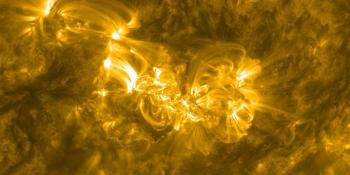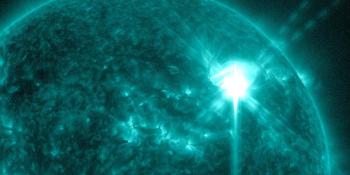Viewing archive of Thursday, 5 January 2012
Solar activity report
Any mentioned solar flare in this report has a scaling factor applied by the Space Weather Prediction Center (SWPC). Because of the SWPC scaling factor, solar flares are reported as 42% smaller than for the science quality data. The scaling factor has been removed from our archived solar flare data to reflect the true physical units.
Report of Solar-Geophysical Activity 2012 Jan 05 2200 UTCPrepared by the NOAA © SWPC and processed by SpaceWeatherLive.com
Joint USAF/NOAA Report of Solar and Geophysical Activity
SDF Number 005 Issued at 2200Z on 05 Jan 2012IA. Analysis of Solar Active Regions and Activity from 04-2100Z to 05-2100Z Solar activity has been at low levels for the past 24
hours with two C-class events observed. The first C-class
flare was from Region 1390 (N09W71), which had an associated Type II
radio sweep with an estimated shock speed of 695 km/s. Due to the
location of this region, and the lack of a CME in imagery, no Earth
impacts are expected. The second C-class flare was a long duration
C2 flare at 05/1238Z from an eruptive filament channel, located
around Region 1392 (N21W19). The associated CME can be seen in
STEREO ahead and behind imagery and is not expected to impact
Earth. Finally, a new Region emerged on the disk early in the period
and was numbered as Region 1393 (N18W03).
IB. Solar Activity Forecast
Solar activity is expected to be at
low levels with a slight chance for M-class flares for the next
three days (06 - 08 January).
IIA. Geophysical Activity Summary 04-2100Z to 05-2100Z
The geomagnetic field has been at predominantly quiet levels for the
past 24 hours. From 05/1200-1500Z, the mid latitudes observed
unsettled conditions while an isolated period at minor storm levels
was observed at high latitudes. This small increase in activity was
due to a sustained period of the negative Bz component of the
Interplanetary Magnetic Field. Solar wind speeds, as measured by the
ACE spacecraft, fluctuated around 340 km/s throughout the period.
IIB. Geophysical Activity Forecast
The geomagnetic field is
expected to be at mostly quiet levels on day one (06 January),
unsettled to active levels with a slight chance for minor storm
levels at high latitudes on day two (07 January) and predominantly
unsettled levels on day three (08 January). The increase in activity
is due to the arrival of a coronal hole high speed stream.
III. Event Probabilities 06 Jan to 08 Jan
| Class M | 10% | 10% | 10% |
| Class X | 01% | 01% | 01% |
| Proton | 01% | 01% | 01% |
| PCAF | green | ||
IV. Penticton 10.7 cm Flux
Observed 05 Jan 141 Predicted 06 Jan-08 Jan 140/140/140 90 Day Mean 05 Jan 145
V. Geomagnetic A Indices
Observed Afr/Ap 04 Jan 003/002 Estimated Afr/Ap 05 Jan 004/005 Predicted Afr/Ap 06 Jan-08 Jan 005/008-014/010-010/012
VI. Geomagnetic Activity Probabilities 06 Jan to 08 Jan
| A. Middle Latitudes | |||
|---|---|---|---|
| Active | 10% | 30% | 30% |
| Minor storm | 01% | 10% | 10% |
| Major-severe storm | 01% | 01% | 01% |
| B. High Latitudes | |||
|---|---|---|---|
| Active | 15% | 15% | 25% |
| Minor storm | 20% | 35% | 10% |
| Major-severe storm | 10% | 40% | 01% |
Latest news
Latest forum messages
AR3664 272[CME] AR 13664, X1.04, 2024-05-08 55Space Weather Memes 346Filaments and prominences 87Incoming Active Regions 242
More topicsSupport SpaceWeatherLive.com!
A lot of people come to SpaceWeatherLive to follow the Sun's activity or if there is aurora to be seen, but with more traffic comes higher server costs. Consider a donation if you enjoy SpaceWeatherLive so we can keep the website online!

Space weather facts
| Last X-flare | 2024/05/08 | X1.0 |
| Last M-flare | 2024/05/08 | M2.0 |
| Last geomagnetic storm | 2024/05/06 | Kp5 (G1) |
| Spotless days | |
|---|---|
| Last spotless day | 2022/06/08 |
| Monthly mean Sunspot Number | |
|---|---|
| April 2024 | 136.5 +31.6 |
| Last 30 days | 164.7 +73.8 |


